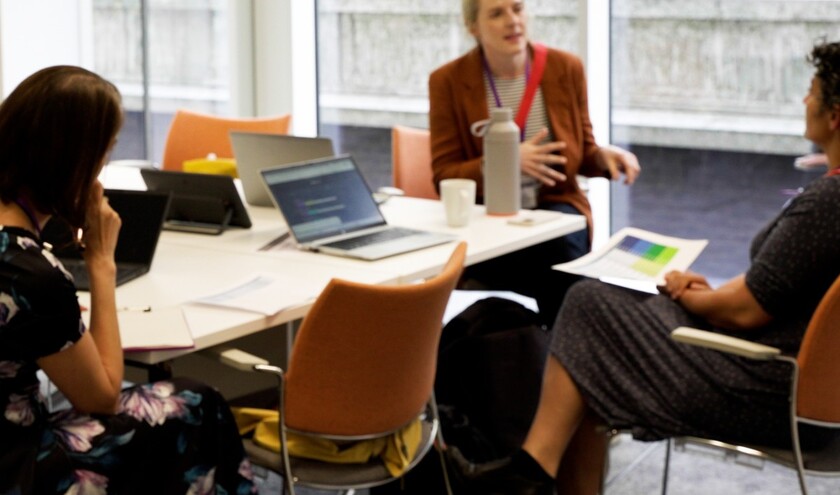The two-day project included over 100 professionals drawn from organisations representing health, local government, wider public services and the VCSFE sector alongside individuals with lived experience who undertook the role of residents and patients.
‘The aim was to create something which felt as real as possible,' said Kennedy.
The simulation, covering a one-year period, involved two neighbouring boroughs in London with populations of 60,000 and 30,000, respectively.
‘We used various different AI tools to generate, based on a typical Joint Strategic Needs Assessment in London, a set of patients and residents, from young people through to older people, that typified the kind of people that you would find living in those neighbourhoods,' said Morioka.
‘Then we developed from that a map of all the individual professionals that would come into contact with those people in the current system and all the people who you would want to be around that person to get a better outcome in the future and generated different scenarios for how they could then interact.'
A community hospital, school, care home and community café were created as part of the simulation.
‘The overriding theme was that neighbourhood healthcare works in terms of improving patient outcomes and delivering services in a way that is both more efficient and effective as a model,' Morioka said. ‘The second point was that things got worse before they got better.'
When asked how long it took to get over this spike in demand, Morioka said ‘we saw improvement within a year'.
He added: ‘Part of this is about saying that in the year when you really start to focus on moving resource around and asking people to work differently, you will uncover unmet demand in the first two or three quarters, you will have to work out ways of front loading some of the resourcing in that year or making allowances for the fact that people will be focused on working differently.
‘When we extrapolated the end of year one performance across the second year, we got to the kind of cost avoidance and improvements in health outcomes that we were seeing at the end of the simulation.'
Morioka said neighbourhood health represented a ‘cultural and behavioural shift'.
‘It could be enabled by new contracts and better funding flows and different types of commissioning, but ultimately, it will not work if we don't persuade people at the frontline the value of working differently and of the fact they will be supported by the people who they don't even know to get the right outcome for the patients and residents they're working with,' he said.
‘There are some things we can do around co-location, around investing in team building, in changing the way in which people are performance managed. There's a number of very practical things for how you might support that behaviour and cultural shift. It's not something that we think you can just wave a magic wand or tell people to behave differently. There's some things we do now that we need to change which will help people to adopt a more holistic way of working.'
The exercise achieved impressive outcomes with annual cost avoidance of up to £49m per place partnership and £12.3m savings from the reduction in avoidable A&E attendances and non-election admissions per neighbourhood.
Kennedy said the simulation also demonstrated the importance of secondary prevention, commenting: ‘We tend to see primary prevention being the best form of prevention and secondary prevention being the second best. But the reality is, because of the data that we had and the insight we had and in the simulation the ability to share that data, we were able to make sure that a range of professionals were aware of the risk factors that somebody had and their role was to manage those risk factors to prevent any exacerbations or additional conditions developing.'
Given the simulation's success, the obvious question is: ‘why hasn't this been done before?'
‘There's almost a national agreement that this is the direction we need to go in now,' Kennedy said. ‘And those of us who've been trying to do this assignment for two decades said: "we know this is the only way this is going to work in the long run." '
Morioka said the NHS had to make neighbourhood health work this time as ‘we don't have a plan B'.
‘We've spent many years trying to invest in services, trying to grow capacity, but the demand has always outweighed our ability to meet it. And part of the reason for that is, obviously that the challenges that are facing individual communities are beyond any particular individual service to address.
‘We're swapping the inevitability of defeat for the possibility of achieving something different. It won't be easy and there's going to be lots of false starts. The simulation also showed that some things people tried didn't work, but actually, by being consistently focused on delivering for the individual, what we're saying is that there's plenty of evidence from this and elsewhere that you can actually make a difference, not just to health outcomes, but also to wider system performance.'
Looking ahead, PPL intends to build on the findings of the exercise with a second simulation, which will explore the use of AI, at the NHS Providers Annual Conference and Exhibition on November 11-12.
If you'd like to take part you can register your interest here.



